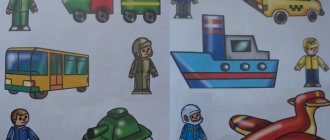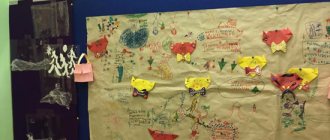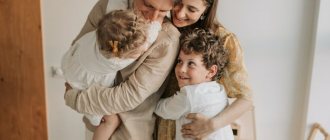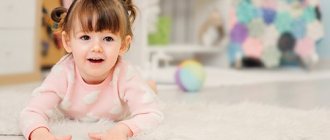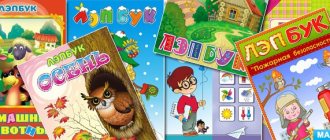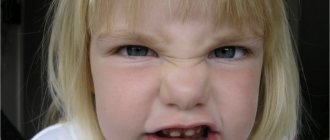1. Learn the concept of “many - little”.
2. Closer to three years - master the concept of “more-less” (determine the number of objects in a group - which ones are more and which ones are smaller).
3. Learn to distinguish between the number of objects “one” and “two”. (At a minimum. You can go further, learn to count to 3 - 4, but not all children aged 2 to 3 can do this - take into account the child’s interest and his abilities).
4.Learn to sort objects - by size, by color, by type (sort different types of pasta, buttons, large and small objects (circles, squares, etc.)), try other types of sorting.
5. Learn to navigate in space (learn the concepts of higher, lower, right, left).
6. Fold yourself, without the help of your mother, elementary puzzles or cut-out pictures from 2-3-4 parts (this skill develops gradually and becomes more developed closer to three years; at first, the mother helps the child).
7. Learn to match - play “who eats what”, “where is whose house”, “where is whose tail” (with cards or in pictures in books and manuals).
8. Play riddles - the mother describes an object or animal in the simplest form, the child guesses it from the description (for example - small, fluffy, with long white ears, jumps like that and eats carrots, who is it? Who says “moo-moo” and gives milk? Etc. Gradually you can complicate the riddles).
9. Guess the animal from the description.
10. Stack several nesting dolls and cups into each other.
11. Build a tower from cubes/cups with decreasing size values
12. Learn to compare figures, geometric bodies with their projections (Dyenesha blocks, homemade preparations)
13. Closer to three years - designing simple structures according to drawings
14. Starting from 2.5 years old - play “Fold the Square” by Nikitin (at first - together with the child, but very quickly children learn to assemble it on their own)
15. Starting from 2.5 years old – play with prefabricated puzzles
16. Learn to classify objects according to a general characteristic (for example: cards with pictures of toys, food, animals are laid out in front of the child. The child is asked to arrange them into appropriate groups (for example, toys in a box, food in a “refrigerator”, animals in a “house”). At first, the child learns to arrange objects with the active help of his mother.For the learning to be successful, it is better to play for a long time with the same set of objects (for example, to begin with, for a long time sorting cards of only toys and food).
Cards or wooden “Pick a Group” toys are great for mastering this skill:
17. Classification of objects - play the game “what’s in this room?” (find what is round in this room? What is soft in this room, etc.).
18. Games with Dienesh blocks, with a simple construction set, and other suitable items (toys, pasta, buttons, beads, etc.) by type:
– find objects, figures of the same shape;
– find objects, figures of the same color;
– find objects, figures of the same size;
– find the same figures by size, thickness and other characteristics.
19. Games with Cuisenaire sticks.
20. Play “part and whole” – “whose tail is this”, “match the roof to the house”, etc.
21. Learn to find a figure based on two signs (for example, find a large yellow circle (in a group of objects there is also a small yellow circle and circles of other colors), a small red square, etc.).
22. Closer to three years (and very individually) - find mistakes in pictures (working with manuals) - what is missing, what is wrong, which of the objects is the wrong color, etc. The very inexpensive manuals from the “Smart Books” series are great for this:
Studying the properties of objects.
1. Colors of objects.
2. Geometric figures, shapes. 3. Long-short. 4. High - low. 5. Wide-narrow. 6. Same and different (closer to three years). 7. Warm-cold. 8. Hard-soft. 9. Smooth-rough. 10. Heavy-light. 11. Taste, smell. Development of attention.
1. Play “Find it!” – we ask the child to find an object in the room (find where your teddy bear is, where the red cube is), on the street (look through the window - find where the dog is walking? Find the red car!), search in a picture in a book, etc. .P. – you can play anytime, anywhere. This game is very simple, children are easily drawn into it. At the same time, attention and the ability to concentrate it develop very well.
2. The game “Find a Pair” is a more complicated version than it was for a year or two - find a pair among objects that are very similar to each other.
3. Find the same pattern (pairs of mittens, hats, cups and saucers, patches for towels, roofs for houses, etc.)
5. Games with Dienesh blocks, Cuisenaire sticks.
6. Search for objects based on one characteristic - find what is red, hard, soft, round, large, etc. in this room. (you can play anywhere).
7. Search for objects based on two characteristics - find what is large and white, small and hard, etc. in this room.
8. Play hide and seek with the child (hide so that the baby can easily find it, prompt the child by calling him with your voice). How to develop memory.
1. “What’s missing?” - remember the pictures (toys) laid out on the table, guess which picture mom hid. Memorizing objects is carried out in a playful way - the mother tells a fairy tale about objects that are laid out on the table; during the process of the fairy tale, the child manages to remember its characters well. After this, mom takes one of them and asks “who is missing?” You can read more about how to play this game with very young children here.
2. What appeared? – we play according to the same principle as written in the previous paragraph, but we do not hide, but add toys, the child must determine which toy the mother added.
3. Hide 3-4 toys with the child. Then ask him to find them (we search from memory).
4. Ask the child to bring 2-3 items (we bring items from memory).
5. Together with the mother, remember what the child did yesterday, in the morning, some time ago, what events happened on the street (which friends were out today, what toys they had, etc.).
6. Remember what is drawn in the picture and answer questions about what was drawn there after the picture is closed.
7. Game “Find a Pair” with hide and seek – the mother shows the child a picture and hides it behind her back. Asks to find the same picture in a group of cards (the child looks for a paired picture without holding it in his hand, as usual, but from memory)
8. Game of “thimbles”. We take multi-colored cups and put a toy under one of them. We swap the cups several times, then ask them to find where the toy is hidden (we gradually increase the number of toys and cups).
9. “Memory” – a game with 2-3 cards. We put cards in front of the child, the child remembers them (to help him, you can tell a fairy tale about the heroes who are drawn in the pictures; while listening to the fairy tale, the child will remember the location of the cards well. The “fairy tale” can be very simple from 4-5 sentences). We turn the cards picture side down - this way, all the pictures are hidden from the baby and are not visible to him. We ask the child to find where a certain card is located from memory (“find which card has a bear on it?”). Another version of “Memory” can be found here. Physical development.
1. Jump in place on two legs. Closer to three years - learn to jump forward (but not everyone succeeds in this).
2. Learn to throw and catch a ball, throw a ball against a wall.
3. Throw up a balloon or ball.
4. Maintain balance while walking along a board placed on the floor, along a bench, or a beam.
5. Depict animal movements as shown by mother.
6. Crawl (like a boa constrictor, like a caterpillar) on your stomach forward.
7. Jump like a bunny.
8. Pretend to be a bird - wave your arms while running around the room, squat - “look for grains in the grass”, jump - “fly up”.
9. Stomp loudly, raising your legs high, like an elephant.
10. Swim like an octopus: lie on your back, raise your arms and legs up, wave your arms and legs (“swim”).
11. Run fast, slow, on your toes.
12. Sitting on the floor, knock on the floor with your feet, “like a drum.”
13. Roll on the floor like a bun.
14. Jump from a half-squat like a frog.
15. Dance and practice logorhythmics (to the music of the Zheleznovs and other authors).
16. Lift objects from the floor by bending or squatting.
17. Reach your arms up, reaching for objects that are located high (the mother can hold objects at the height of the child’s outstretched arm).
18. Move around the room without touching objects scattered on the floor (for example, pillows), gradually increasing the pace and number of objects.
19. Carry large, but not heavy things (for example, a highchair, a light box of toys).
20. Walking on massage surfaces.
21. Walking on tiptoes, closer to three years - on heels.
22. Perform dance movements - place the foot on the toe, on the heel.
23. Walking along a winding line drawn on the floor (or a strip of paper) - development of coordination.
24. Crawling under a tight rope.
25. Game “Catch a sunny bunny” - we play with a sunny bunny that mom lets out.
26. Collective games: dance in a circle, run like a train after each other (children hold on to each other), games with a special children’s play parachute, games of “catch up”, “wolf and bunnies”, etc.
27. "Cat and mouse." While the cat is sleeping (an imaginary cat or another adult), the children and mother walk quietly. When the cat wakes up, they quickly run into the house.
28. Hanging on the horizontal bar, rings, mother’s hands.
29. Climb on sports walls at home, on playgrounds.
30. Walking on “bumps” (chaotically scattered pillows, books).
31. Climb through a tunnel (purchased or built from chairs placed in a row).
32. Fitball games.
33. Game “Snail and House”. The child gets on all fours. A pillow is placed on his back. He turns into a snail, which carries its house (pad) on its back. The snail's task is to walk as long as possible without dropping its house (we crawl on all fours, carrying a pillow on our back).
34. Walking on your hands
Music and rhythm.
1. Listen to a lot of songs according to age.
2. Learn to listen to music - listening to classical melodies with your mother, listening to your mother’s story “What does this melody tell us?” It’s easy to come up with such a story yourself (for example, like this), with its help the child develops the ability to truly listen to music, to capture its shades and mood.
3. Learn to distinguish between fast and slow music, learn to play noise musical instruments quickly and slowly.
4. Learn to distinguish between happy and sad music.
5. Learn to distinguish between loud and quiet music, learn to play noise musical instruments loudly and quietly.
6. If there is an opportunity (large family) to play the game “who called?” (the child guesses by voice who is calling him).
7. Listen with your mother to the “sounds of life” - birds chirping, a car making noise, leaves rustling, etc.
8. Try to determine where the sound is coming from (for example, “do you hear a bird chirping? What tree do you think it’s sitting on?”).
9. Practice logorhythmics (to the music of the Zheleznovs and other authors).
10. Play musical instruments (children's and noise instruments - drum, maracas, tambourine, xylophone, etc.).
11. Get acquainted with various instruments and their sounds (you can watch videos on YouTube with your child, where performers play classical music on various instruments).
12. Closer to three years (if the child is fond of songs and remembers many melodies by ear) - play guess the melody - the mother sings the melody (“A Christmas tree was born in the forest”, “Antoshka”), the baby guesses what kind of song it is.
13. Sing songs to your child.
14. Dancing - fast, slow, stamping your feet, clapping your hands, twirling your palms - the "flashlight" movement, jumping, putting your feet on your toes - on your heels when dancing, tapping your heel on the floor, tapping your toes on the floor, doing a round dance, dancing with objects – spoons (we dance and knock spoons on the floor, against each other, over our heads, behind our backs, loudly-quietly, quickly slowly), maracas rattles (we dance and accompany ourselves, perform the same movements as with spoons), with handkerchiefs ( alone and in pairs with mom.)
15. Encourage independent performance of dance movements to dance tunes. Intensify the performance of movements accompanied by music that convey the character of the animals depicted. Drawing.
1. Draw paths.
2. Draw circles
3. Draw simple compositions - rain, snow, grass, Christmas tree decorations on the tree, circles (which will be balls, apples, etc.), draw sticks - strings for balls, stems (sticks) for flowers, handles for shoulder blades, hedgehog needles, grass, patterns (random) on cups, rugs, towels.
4. Draw vertical and horizontal lines.
5. Draw short and long lines.
6. Closer to three years - color pictures (some drawing teachers are against coloring - they believe that coloring kills creativity (since the child does not draw on his own, but works according to a ready-made template). Decide individually whether to teach your child to color or not).
7. Draw the child’s attention to the choice of color for the drawing (we draw the grass in green, the rays of the sun in yellow).
8. Draw with a stick on sand, semolina, snow.
9. Leave prints with paints using stamps and sponges.
10. Learn to paint with paints (wash and wet the brush).
11. Paint with finger paints. Modeling.
1. Roll out plasticine and dough with straight and circular movements of your hands (balls and sausages).
2. Break off small lumps from a large lump, flatten them with your palms and fingers.
3. Connect the ends of the rolled stick, pressing them tightly against each other.
4. Just play with dough and plasticine (free creativity).
5. Sculpt lumps of plasticine onto paper (feed the chicken, make dots for the ladybug, etc.).
6. Master the technique of smearing plasticine on paper.
7. Leave imprints on the dough with various objects.
8. Cut out shapes from the dough using cookie cutters.
9. Learn to cut dough with a plastic knife. Application.
1. Make a plot applique (sun + cloud + house, etc.) from 2-3 objects.
2. Apply an object of 2-3 parts (houses (roof + window), mushrooms (hat + leg), etc.).
3. Applique made of cotton wool (depict clouds, snow, dandelions, sheep, etc.).
4.Applique made from crumpled up lumps of paper.
5. Applique made from torn paper. Construction.
Build houses, fences, bridges, a slide, a garage. Play with Lego. Closer to three years - build houses according to a simple drawing (from two or three parts). Games with Dienesh blocks. Games with Cuisenaire sticks.
The world.
1. Continue studying domestic and wild animals and their young. Learn simple facts about animals (where they live, what they eat, characteristic features, for example, “a cow gives milk”, “a goat butts”, etc.), learn what domestic animals give to a person, learn the names of the main parts of an animal’s body (horns) , hooves, etc.).
2. Birds - expand your knowledge about bird species, study basic facts about birds (where they live, what they eat, how offspring appear, names of chicks). Get acquainted with the division into domestic and wild birds (simply talk about this with the child, when studying birds, emphasize that someone lives next to a person and benefits him, someone is a wild bird and lives on its own).
3. Insects – study the most common insects (ant, bee, butterfly, etc.); know the simplest facts from their life (a bee brings honey, a caterpillar gnaws on leaves, etc.), recognize them by their appearance, and cultivate a kind attitude towards insects.
Norms of speech development
A three-year-old child already has a fairly rich vocabulary: at least 1000 words. The clarity of speech at this age is not yet impeccable: the baby may distort words and have difficulty pronouncing individual sounds correctly. A three-year-old is already able to reason in a simple form about an object or event he saw.
A 3-year-old child does not speak or speaks little: what to do?
At three years old, a child’s speech skills are sufficiently developed to be able to communicate with other people. Normally, by the age of three years, a child has the following speech skills:
- understands the questions asked and answers them;
- knows his first and last name well;
- speech becomes coherent, resembling a story: one sentence follows from another;
- describes the picture he saw, paying attention to details;
- retells short tales and stories.
Children who speak almost or not at all by the age of three are quite common. The famous Russian pediatrician Evgeniy Komarovsky advises parents whose children at 3 years of age do not yet speak to pay attention to the type of stubborn silence: is the child silent because he does not understand the speech of those around him, or does the baby understand everything, but says nothing?
If a child shows signs of understanding without using words, perhaps silence is his personal trait. Three-year-old silent children, according to pediatrician statistics, are more common among boys—for every one non-talking girl, there are four such boys. According to the same statistics, at least 7% of children aged three years do not speak at all.
In any case, if a three-year-old child does not speak at all, you need to visit a pediatrician with him. Based on the examination results, the doctor will recommend ways to solve the problem or refer you to specialized specialists.
The principle of constructing classes for preschoolers
All classes for preschool children are based on the principle of playful learning and development. Children better assimilate information that is presented to them unobtrusively, in the form of a game.
Classes should be conducted after a night or daytime sleep - this is the very time when the preschooler is ready to learn new material. The duration of classes should not exceed 25 minutes.
For classes, you need to prepare props, make a plan and think through a scenario. It is better if all the exercises in one lesson are united by a common plot. This could be a certain fairy-tale hero who comes to visit the baby and needs help. The latter helps the guest solve problems and find a way out of the situation, simultaneously learning the material and the necessary knowledge.
Garden.
Your child will be incredibly happy and interested if you together organize his own small garden outside this summer. Even if you live in a high-rise building, you will definitely find a secluded place on the lawn near your house. Together with your baby, fence it off with pebbles or a small fence, clear it of vegetation, loosen the soil and water it.
And then do whatever you want: plant flowers, carrots, strawberries together... Or maybe you should plant a real beauty - grow a huge sunflower from a small seed?
Teach your child to look after your pets - weed weeds, water (in the morning or evening, explain what will happen if you water the garden in the middle of the day under the hot rays of the sun). Together, rejoice at the first shoots, admire the results of your work, and decorate the flowerbed with funny figures.
What does this give to the child?
Working in the garden for a child is his first biology lessons, a visual acquaintance with the life of plants. In addition, such manual labor develops motor skills, teaches responsibility, and simply makes you happy.
Development of fine motor skills
The fine motor skills of a three-year-old are becoming more and more perfect. The child develops previous skills and acquires new ones:
- enjoys repeating finger gymnastics exercises;
- reinforces speech with gestures, and if the baby is emotional, gestures can be very active;
- builds buildings of different sizes and configurations from cubes;
- learns to use scissors and can cut out simple shapes from paper;
- knows how to sculpt simple structures from plasticine: flagella, balls;
- confidently grasps and holds objects;
- opens loose caps on bottles.
Content:
- Basic skills of a child at 3 years old
- Physical development: main indicators Height and weight
- Physical skills
- Motor skills
Physical development: main indicators
The physical development of a child is assessed according to three main criteria: height and weight, physical abilities, and motor skills.
Height and weight
The height and weight of two children at the age of three can differ significantly - these physical parameters depend on hereditary factors and, to a lesser extent, on the child's gender and lifestyle. In pediatrics, the “golden mean” for the weight of a three-year-old is considered to be 15 kilograms, for height - 95 centimeters .
If your baby’s height is 10% less than the standard 95 centimeters, this is not a cause for concern, but, most likely, a personal developmental feature. But if your son or daughter’s height at 3 years is less than 85 centimeters, you should think about eliminating negative factors: try to adjust the baby’s diet and organize reasonable physical activity for the child, after consulting with a doctor.
In the weight parameters for a three-year-old child, deviations of 20% are allowed in both directions from 15 kilograms. If the baby’s weight is less than 12 or more than 18 kilograms, you may need to reconsider the diet, taking into account the recommendations of pediatricians.
Physical skills
Basic physical skills of a three-year-old:
- knows the terrain well enough, remembers familiar routes;
- draws and makes simple appliqués himself;
- knows how to ride a tricycle:
- claps his hands and stomps his feet well;
- With the help of his parents, he assembles quite complex construction sets, and also puts together multi-part puzzles with outside help.
Motor skills
By the age of three, the child’s motor activity develops noticeably even compared to the period of several months preceding the third birthday. Basic motor skills of a child at three years old:
- maintains balance while standing on one leg;
- climbs and descends stairs without assistance;
- plays various ball games;
- runs, rarely stumbling and falling;
- repeats simple dance movements: jumps, rises on tiptoes.
Mental development
Along with the crisis of three years comes the age of “why”. The child asks adults about everything in the world, compares the answers, and draws conclusions.
The pace of mental development in different children may differ depending on the child’s personal abilities and the involvement of adults in the development process. Intellectual development at the age of three is considered normal if the child can:
- distinguish 4-8 colors;
- examine the object not only as a whole, but also notice details;
- do not be distracted too often, concentrate on one activity;
- make simple plans, for example: “in the morning we will go to kindergarten, and in the evening you will take me home”;
- count to five;
- find answers to children's riddles;
- operate with the concepts of “more-less” and find other differences between objects;
- memorize simple poems and songs;
- distinguish basic geometric shapes from each other - circle, triangle, rectangle, square - and name them.
Communication skills and emotional sphere
A three-year-old child needs to communicate with peers more than before. The child is already learning to manage emotions and trying to resolve conflicts peacefully. At the same time, the three-year-old feels an urgent need to express his “I”, which leads to capricious behavior towards parents and other close people. Closer to four years, the child begins to understand other people's emotions, learns to control himself and excessive whims disappear.
The emotional sphere of three-year-old children is actively developing: they begin to fantasize. The guys with the richest imagination even surprise others with stories of their own creation. Normally, an emotionally developed child at 3 years old strives to repeat the actions he likes after other people, and knows how to express likes and dislikes.
Development of hearing, vision, touch, taste
The hearing of three-year-old children requires especially careful attention. At this age, children often catch colds, which can lead to otitis media and, as a consequence, hearing impairment.
In order not to harm your child’s hearing, be sure to teach him to breathe through his nose and not his mouth, treat a runny nose in a timely manner and try to avoid sudden changes in temperature.
The vision of three-year-old children is not yet sharp enough compared to children of older preschool age. Vision is fully formed only by 6-7 years. You should not try to teach your child to read as early as possible - children's vision is ready for reading only at the age of five . Of course, you can show books to a three-year-old, but the books must use large font. To preserve fragile children's vision, reduce your child's contact with the phone, computer, and TV.
At 3 years old, children’s sense of touch is well developed: they distinguish between cold and hot water, warm and cold wind, rough and smooth surfaces. The taste buds of a three-year-old child are developed in the same way as those of an adult. It distinguishes between sweet, bitter, sour and salty tastes, preferring sweets.
Cognitive development
Children's cognitive skills include the development of perception, attention, memory, and thinking. The speed of cognitive development is influenced by the child’s exploration of the world around him: the more the baby interacts with different objects and the more he observes different phenomena, the better his cognitive abilities develop.
It is important for three-year-old children to experience the world in practice, which is why it is so important to reinforce the child’s personal experience with explanations from an adult. For example, explain the difference between opposing concepts (“narrow path - wide road”), encourage the child’s desire to analyze situations and events, and focus on specific details of objects.
At the age of three years, a child, with the help of perception, forms an idea of the properties of objects. He learns to compare the sizes and shapes of objects, knows the purpose of different things and uses them correctly.
The baby's attention becomes stable: he focuses on an interesting activity for 10-20 minutes, does not let several objects out of his sight at the same time. But a three-year-old can still get distracted quite easily.
Memory at three years of age is involuntary: a child remembers information that is interesting to him, but it is not yet easy for a child to learn something specifically.
Although the child can already establish cause-and-effect relationships, his thinking is still limited to the present time. A three-year-old child evaluates the situation “here and now,” but as the child learns about the world, his ability to analyze gradually develops. At the age of 3, children especially clearly feel the joy of a discoverer, and the more events that happen around the young explorer, the better his thinking develops .
